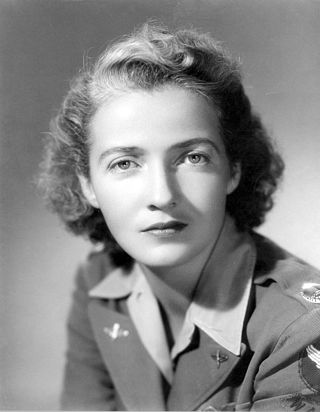
Nancy Harkness Love, born Hannah Lincoln Harkness, was an American pilot and airplane commander during World War II. She earned her pilot's license at age 16. She worked as a test pilot and air racer in the 1930s. During World War II she convinced Colonel William H. Tunner of the U.S. Army Air Forces to look to set up a group of female pilots to ferry aircraft from factories to air bases. This proposal was eventually approved as the Women's Auxiliary Ferrying Squadron. Love commanded this unit and later all ferrying operations in the newly formed Women Airforce Service Pilots. She was awarded the Air Medal for her work during the war and was appointed lieutenant colonel in the US Air Force Reserve in 1948.

Oveta Culp Hobby was an American government official and businesswoman who served as the first United States Secretary of Health, Education, and Welfare from 1953 to 1955. A member of the Republican Party, Hobby was the second woman ever to serve in a presidential cabinet.
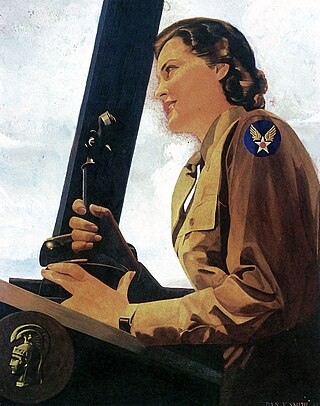
The Women's Army Corps (WAC) was the women's branch of the United States Army. It was created as an auxiliary unit, the Women's Army Auxiliary Corps (WAAC) on 15 May 1942, and converted to an active duty status in the Army of the United States as the WAC on 1 July 1943. Its first director was Colonel Oveta Culp Hobby. The WAC was disbanded on 20 October 1978, and all WAC units were integrated with male units.
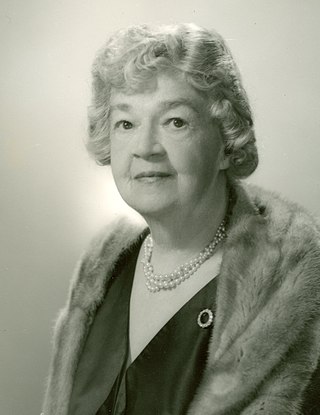
Edith Rogers was an American social welfare volunteer and politician who served as a Republican in the United States Congress. She was the first woman elected to Congress from Massachusetts. Until 2012, she was the longest serving Congresswoman and was the longest serving female Representative until 2018. In her 35 years in the House of Representatives she was a powerful voice for veterans and sponsored seminal legislation, including the Servicemen's Readjustment Act of 1944, which provided educational and financial benefits for veterans returning home from World War II, the 1942 bill that created the Women's Army Auxiliary Corps (WAAC), and the 1943 bill that created the Women's Army Corps (WAC). She was also instrumental in bringing federal appropriations to her constituency, Massachusetts's 5th congressional district.

Mary Agnes Hallaren was an American soldier and the third director of the Women's Army Corps (WAC) at the time that it became a part of the United States Army. As the director of the WAC, she was the first woman to officially join the U.S. Army.

Second Lieutenant Carmen Maria Lozano Dumler, RN,, was one of the first Puerto Rican women to become a United States Army officer. During World War II, she served as a nurse and interpreter, and provided support for patients who spoke Spanish. Lozano Dumler has since been featured in promotional and recruitment materials that celebrate diversity in the US military.

Fort Huachuca is a United States Army installation, established on 3 March 1877 as Camp Huachuca. The garrison is now under the command of the United States Army Installation Management Command. It is in Cochise County in southeast Arizona, approximately 15 miles (24 km) north of the border with Mexico and at the northern end of the Huachuca Mountains, adjacent to the town of Sierra Vista. From 1913 to 1933, the fort was the base for the "Buffalo Soldiers" of the 10th Cavalry Regiment. During the build-up of World War II, the fort had quarters for more than 25,000 male soldiers and hundreds of WACs. In the 2010 census, Fort Huachuca had a population of about 6,500 active duty soldiers, 7,400 military family members, and 5,000 civilian employees. Fort Huachuca has over 18,000 people on post during weekday work hours.
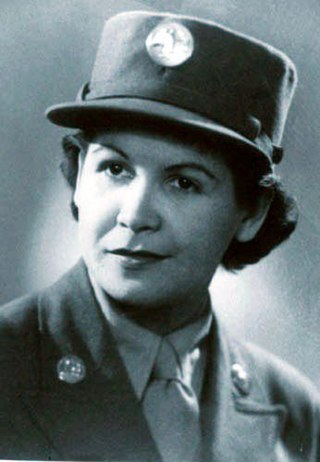
Tech4 Carmen Contreras-Bozak, was the first Puerto Rican woman to serve in the U.S. Women's Army Corps (WAC) where she served as an interpreter and in numerous administrative positions.
Two of the least-known roles played by Puerto Rican women and women of Puerto Rican descent have been that of soldier and that of revolutionary. This is a brief account of some the Puerto Rican women who have participated in military actions as members of either a political revolutionary movement or of the Armed Forces of the United States.

Hispanic Americans, also referred to as Latinos, served in all elements of the American armed forces in the war. They fought in every major American battle in the war. Between 400,000 and 500,000 Hispanic Americans served in the U.S. Armed Forces during World War II, out of a total of 16,000,000, constituting 3.1% to 3.2% of the U.S. Armed Forces. The exact number is unknown as, at the time, Hispanics were not tabulated separately, but were included in the general white population census count. Separate statistics were kept for African Americans and Asian Americans.
Hispanics in the United States Marine Corps, such as Private France Silva who during the Boxer Rebellion became the first Marine of the thirteen Marines of Latin American descent to be awarded the Medal of Honor, and Private First Class Guy Gabaldon who is credited with capturing over 1,000 enemy soldiers and civilians during World War II, have distinguished themselves in combat. Hispanics have participated as members of the United States Marine Corps in the Boxer Rebellion, World War I, the American intervention in Latin America also known as the Banana Wars, World War II, the Korean War, the Vietnam War, the Gulf War and most recently in the military campaigns of Afghanistan and Iraq.

Charity Adams Earley was an American United States Army officer. She was the first African-American woman to be an officer in the Women's Army Auxiliary Corps and was the commanding officer of the 6888th Central Postal Directory Battalion, which was made up of African-American women serving overseas during World War II. Adams was the highest-ranking African-American woman in the army by the completion of the war.

Ann Elizabeth Dunwoody is a retired general of the United States Army. She was the first woman in United States military and uniformed service history to achieve a four-star officer rank, receiving her fourth star on November 14, 2008.
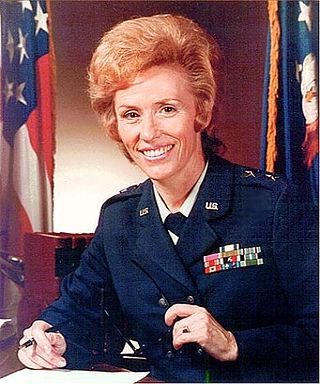
Major General Jeanne Marjorie Holm was the first female one-star general of the United States Air Force and the first female two-star general in any service branch of the United States. Holm was a driving force behind the expansion of women's roles in the Air Force.

PFC Carmen García Rosado was an educator, author and activist for the rights of women veterans who was among the first 200 Puerto Rican women to be recruited into the WAC's during World War II. Her book "LAS WACS-Participacion de la Mujer Boricua en la Segunda Guerra Mundial", is the first book to document the experiences of the first 200 Puerto Rican women who participated in said conflict as members of the armed forces of the United States.

Oliver Williams Dillard Sr. was a United States Army major general, the fifth black officer in the U.S. Army to attain flag rank. He was a member of the Military Intelligence Hall of Fame and Officer Candidate School Hall of Fame, at Fort Huachuca, Arizona and Fort Benning, Georgia respectively.

Mary Elizabeth Clarke was a United States Army officer who was the department head of the Women's Army Corps. She was promoted to the rank of major general in the United States Army and was the first woman to attain this rank. She served in the United States Army for thirty six years, the longest ever served for a woman in the United States Army. In 1978 Norwich University awarded her an honorary doctorate in military science. She retired in 1981 and was on the Women in the Services Defense Advisory Committee.
The 32nd and 33rd Post Headquarters Companies were two all-black units of the Women's Army Auxiliary Corps (WAAC), later becoming the Women's Army Corps (WAC). The two companies were incorporated by fall of 1942 and consisted of 330 members total. They were the first group of WAACs assigned to a military installation inside the United States during World War II. The 32nd and 33rd were assigned to Fort Huachuca, where there was an all-black division of U.S. Army men.
















